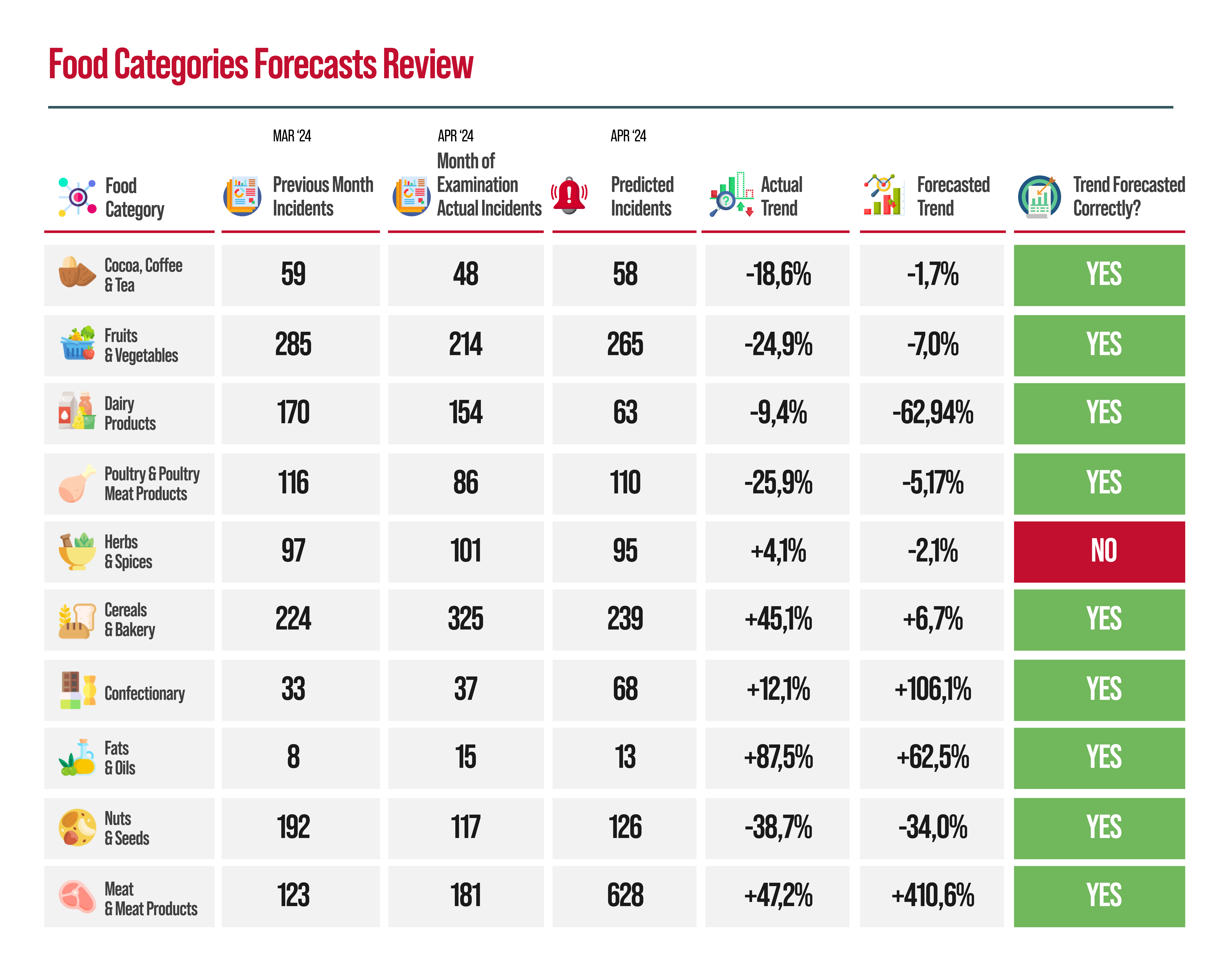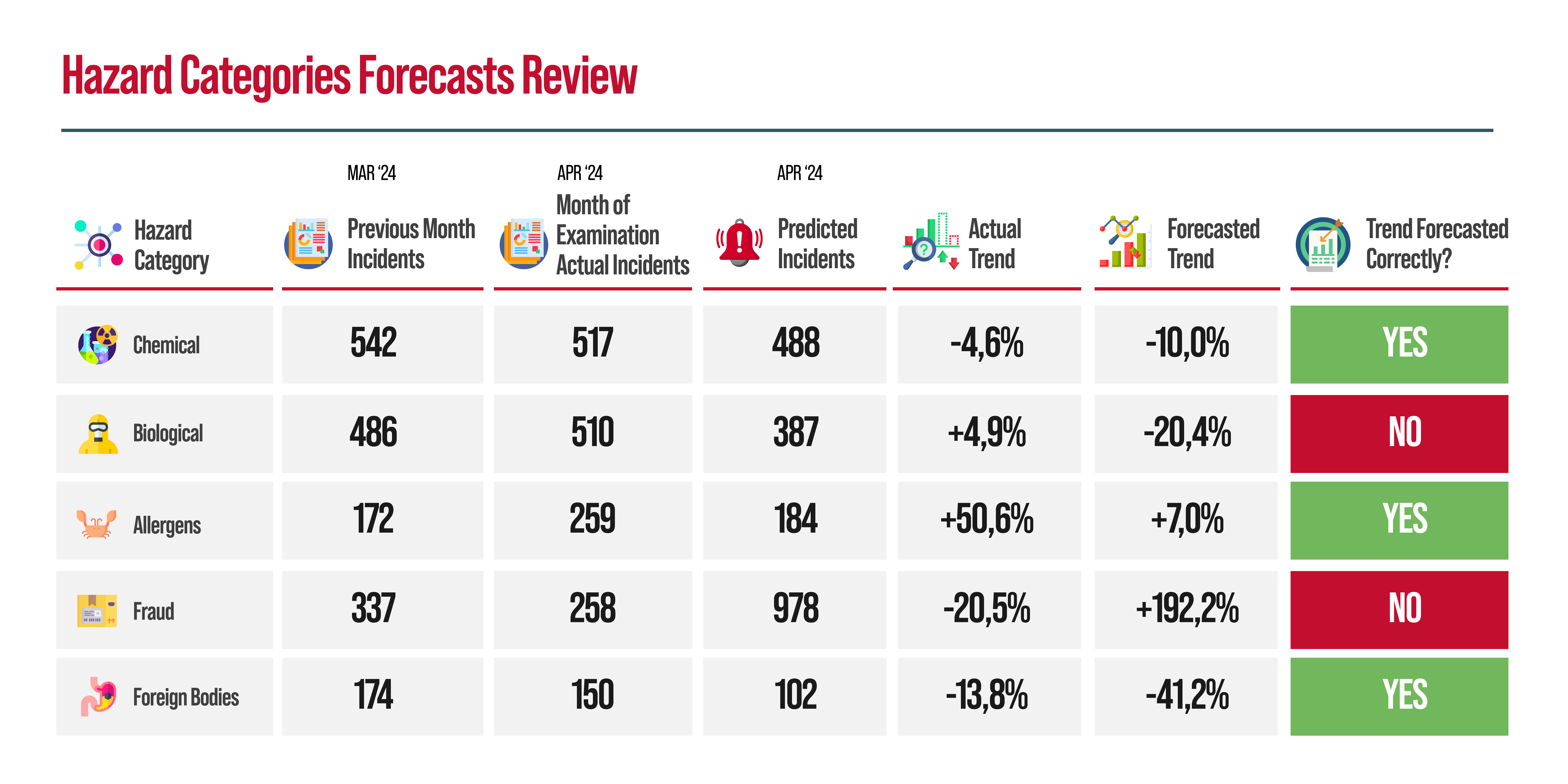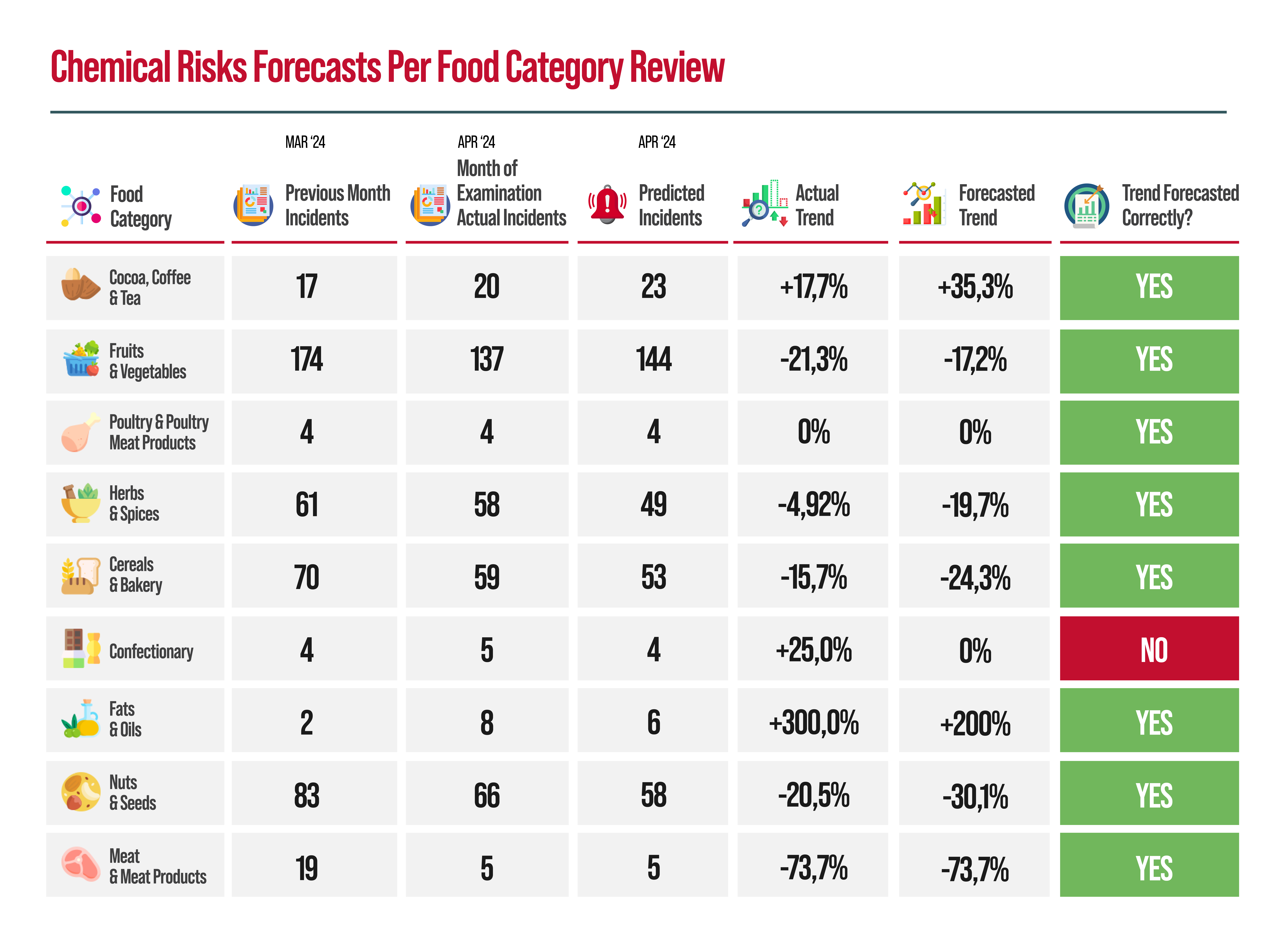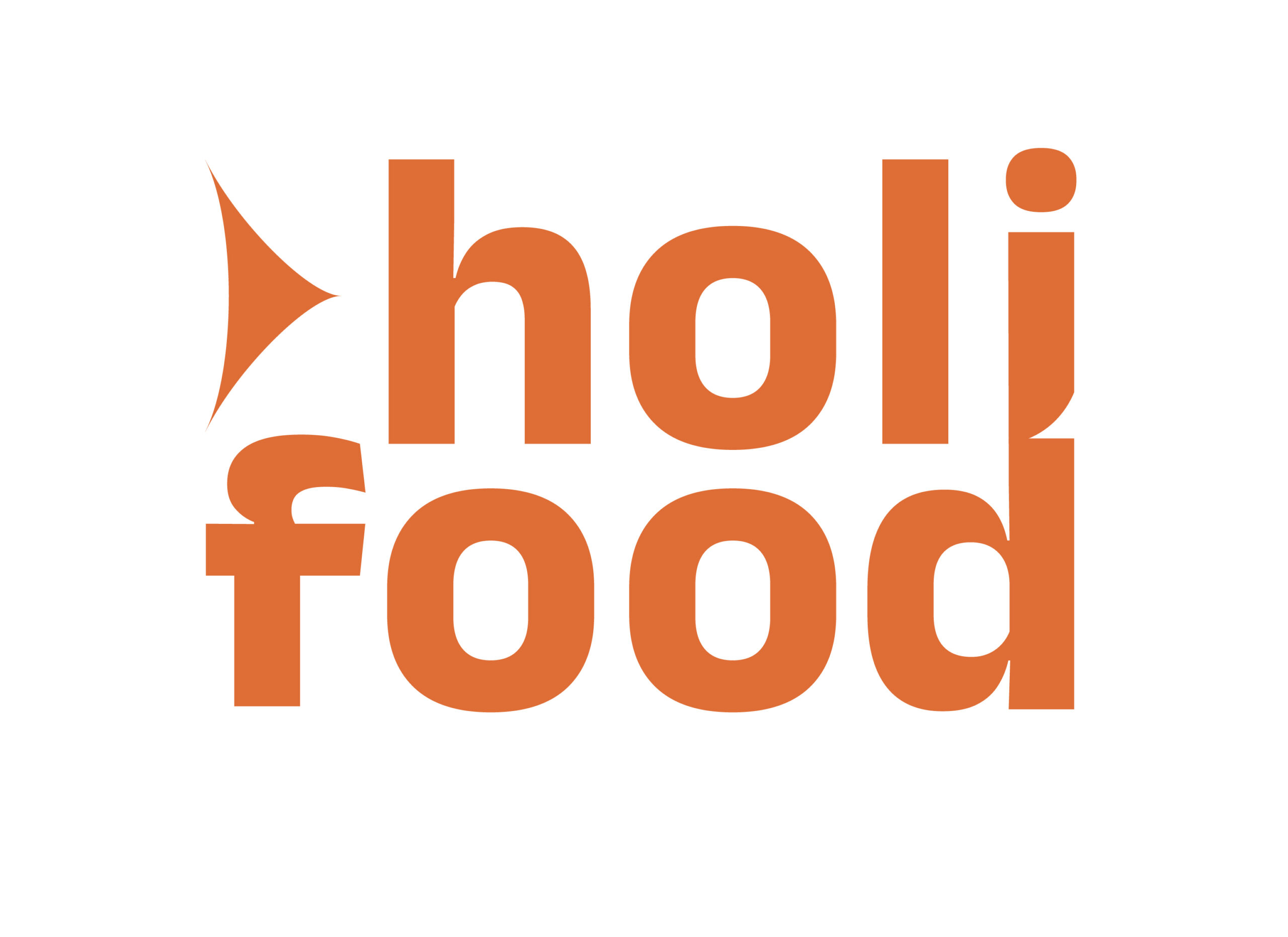
Monthly Forecasts Review: April
Welcome back to our Monthly Forecasts Review Series!
This is the article series where we review our monthly forecasting outcomes, by examining the performance of our incidents forecast’s trends for the previous month, April. More specially, we review the performance of our forecasts for 10 key food categories, the hazards trends forecasts for the top Biological, Chemical, Foreign Bodies, Allergens Hazard Categories as well as Food Fraud. Finally, we take a closer look at the Chemical Hazard Forecasts for these product categories.
How do we perform the review?
We compare the forecasted incidents trend for each food product category, hazard and risk category as highlighted by FOODAKAI, against the actual number of recorded incidents for that month.
FOODAKAΙ is the AI-powered & predictive data analytics platform that collects, harmonizes and correlates data and utilizing continuously trained and updated AI models produces high-accuracy incident forecast trends for all known ingredients, raw materials and hazards.
For our previous edition, read here.
Key Food Categories Forecasts Review
Let’s take a look first at the overall incidents trend forecasts in 10 Key Food Categories for April.

FOODAKAI correctly forecasted the incidents trend for 9 out of the 10 food categories, namely Cocoa, Coffee & Tea, Fruits & Vegetables, Dairy Products, Poultry & Poultry Meat products, Cereals & Bakery, Confectionary, Fats & Oils, Nuts & Seeds and Meat & Meat Products. It didn’t correctly forecast the incidents only in the Herbs & Spices products category.
Highlights:
- In the Cocoa, Coffee & Tea, the Fruits & Vegetables products, as well as the Poultry & Poultry Meat product categories, FOODAKAI forecasted the trend quite accurately with, although anticipating a lower decrease in the number of incidents than the actual.
- In the Dairy products category, while the platform correctly forecasted the decreasing trend, it projected a higher decrease (-62.94%) than the actual (-9.4%).
- For the Herbs & Spices product category, while FOODAKAI forecasted a slight decrease of -2.1%, the actual trend increased by 4.1%, a minor statistical failure.
- In the Cereals & Bakery category, the platform detected an increasing trend but the forecasted value was lower (6.7%) than the recorded (45.1%).
- In the Confectionary category, the platform forecasted the increasing trend successfully but not the level. However, it is generally difficult to fit a robust model for the product category because there is not so much data and due to the lack of seasonality.
- In the Fats & Oils and Nuts & Seeds product categories, FOODAKAI forecasted with exceptional accuracy the increasing and decreasing incidents trend respectively.
- In the Meat & Meat products category, FOODAKAI forecasted an increasing trend. The large difference between the forecasted increase and the actual increase is attributed to an ongoing issue regarding one of the prime sources that delays the publication of relevant incident reports for packaging defect incidents for the product category.
Hazard & Risk Categories Forecasts Review
Now, let’s review the performance of the hazard & risk trend forecasts in comparison to the recorded number of incidents.

FOODAKAI successfully forecasted the incidents trend in 3 out of the 5 Hazard and Risk types: Chemical, Allergens and Foreign Bodies. It didn’t forecast the trend for Biological and Food Fraud incidents.
Highlights:
- For Chemical Hazards incidents, the platform successfully forecasted the decrease in incidents trend with only a slight difference from -10.0% expected to -4.6% to actual.
- For Biological Hazard incidents, a decrease in the number of incidents was forecasted while the incidents increased.
- In the Allergen Hazard type category, although FOODAKAI correctly forecasted the increasing trend, it estimated a lower increase 7% versus the actual 50.6%.
- In the Food Fraud product category, the platform didn’t forecast the trend correctly due to a recurring bug as reported above in the Meat & Meat Products category.
- In the Foreign Bodies Hazard type category,FOODAKA successfully forecasted the decreasing trend, although with a slight difference in the percentages between forecasted and actual incidents.
Chemical Hazards Forecasts Per Food Category Finally, let’s dig deeper into the forecasted vs the actual trends for incidents associated with chemical hazards for these 8 Food Categories. In Dairy Products no incidents attributed to chemical hazards were recorded.

The platform correctly forecasted the chemical hazard incidents in 8 out of the 9 food categories: Cocoa, Coffee & Tea, Fruits & Vegetables, Poultry & Poultry Meat Products, Herbs & Spices, Cereals & Bakery, Fats & Oils, Nuts & Seeds and Meat & Meat products. For the Confectionary products category the incident trend was not forecasted successfully.
Highlight:
- Regarding Chemical Hazards in Cocoa, Coffee & Tea products, the platform forecasted an increasing trend, although with a slight difference in the percentages.
- In the Fruits & Vegetables category, FOODAKAI forecasted with exceptional accuracy a decrease in the number of incidents with -17.2% over the -21.3% recorded.
- For Chemical Hazards incidents Poultry & Poultry Meat products, a bullseye forecasting was achieved with the number of incidents forecasted to remain the exact same, 4.
- In the Herbs & Spices product category, the decreasing trend was validated with only a minor difference in the number of incidents.
- In both Cereals & Bakery and Nuts & Seeds product categories, FOODAKAI forecasted the decreasing trend with exceptional accuracy, with just a slight difference in both cases.
- For Confectionary products, FOODAKAI failed to forecast the increasing trend, and anticipate neither increase nor decrease, however, only a minor difference of 1 incident.
- In the Fats & Oils product category the platform managed to forecast an increasing trend, although anticipating a lower increase compared to the actual.
- Finally, for the Meat & Meat Products category, the platform achieved perfect forecasting, projecting and validating a 73.3% decrease.
To manage the complexities of the food and beverage industry, companies should incorporate highly accurate incident forecasts and trend analyses for each product or ingredient into their critical risk assessment processes. This approach enables them to anticipate emerging and new risks within the supply chain, facilitating the development of a robust risk mitigation strategy. By proactively addressing potential issues, companies can protect themselves against the growing number of recalls and incidents, ensuring product safety and maintaining consumer trust.
Want to learn more about how you can benefit from such forecasts, schedule a dedicated session to discover forecasts about your supply chain.
Want to receive helpful food safety intelligence in your inbox?
 Funding for this research has been provided by the European Union’s Horizon Europe research and innovation programme EFRA (Grant Agreement Number 101093026). Funded by the European Union. Views and opinions expressed are however those of the author(s) only and do not necessarily reflect those of the European Union or European Commission-EU. Neither the European Union nor the granting authority can be held responsible for them.
Funding for this research has been provided by the European Union’s Horizon Europe research and innovation programme EFRA (Grant Agreement Number 101093026). Funded by the European Union. Views and opinions expressed are however those of the author(s) only and do not necessarily reflect those of the European Union or European Commission-EU. Neither the European Union nor the granting authority can be held responsible for them.








